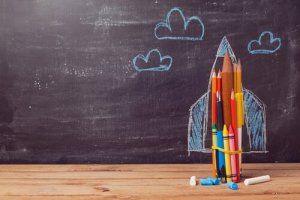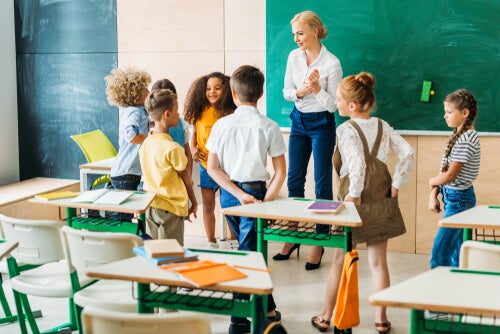We Can Transform Education

Many learning centers have abandoned the lecture format. Instead, they want students to leave the classroom with more than just theoretical knowledge. We’re talking about places that teach children critical thinking skills and transform education. They believe it’s important for students to only accept ideas founded on solid arguments and verified empirical data. These institutions of learning argue that education integrated with new methodologies and learning that’s both cooperative and collaborative are superior to older models.
Under such a system, teachers stop trying to transmit knowledge. Instead, they try to bring out more participation rather than fill students’ minds with knowledge. In other words, educators guide their pupils, setting the topic they’re going to discuss. The students let the teacher know what they’re actually interested in. In most cases, this tends to go beyond just textbook material.

Education beyond books
This is a methodological gamble that sets textbooks aside, prioritizing human development. It allows students to use, among other resources, cell phones and tablets in the classroom. It breaks away with time periods and spaces that normal school organizations traditionally establish. Furthermore, it’s very different from many consolidated systems. As you might imagine, all of this arouses certain fears and doubts from traditionalists.
This methodology requires greater effort than traditional lecture-based classes. Aside from that, it considers textbooks to be the comfort zone. Any other method means more resources, more work, more time, and, most significant, more uncertainty.
Students explore and teachers are mostly guides. Learning is built little by little, with the student creating the content on the basis of different sources of information. In the process, they go about learning to distinguish between trustworthy and untrustworthy information. The objective of testing is also to learn, not only to pass or fail the student. This purportedly aids in the student’s personal and academic development.
Various methodologies that differ from traditional learning
- Flipped classroom. This is a methodology that “flips” the classroom. Specifically, the teachers ask the students to study at home and instead work on group activities in the classroom. They have access to content that the teacher provides and creates. Some examples of such content are blogs and videos. The student really becomes the center of the learning experience. They do participatory activities in a dynamic and interactive learning process. The teacher, on the other hand, takes on the role of just a guiding presence.
- Project-based learning. The main goal of this methodology is for the student to learn by doing. The end result is a final project that addresses a real-world problem. Even so, the truly important thing isn’t the end, but the journey. Through this method, educators can also get the student to apply the knowledge they acquired in diverse and changing circumstances. This is meant to help them understand how to deal with real-life situations more skillfully.
- Gamification. This methodology tries to transfer elements from gaming to education. It’s a way to motivate students in a fun way. As with all games, the instructor establishes objectives and ways of working while playing. They can define levels, different challenges, and prizes. This way, they steer the game to cover the content that they intend to teach.
- Thinking-based learning. This type focuses on getting students to think with a series of guidelines the professor sets. Its main goal, specifically, is to get the students to think reflexively and critically on study topics or contents. It stresses decision-making skills and questioning the veracity of information in order to develop creative ideas and deeper understanding.
Many possible options to transform education
These and many other alternative methodologies are possible options for educators to transform education. They can help to develop a learning and teaching system that doesn’t just focus on memorization in order to pass an exam. Instead, they try to go far beyond that, putting the student at the center of the process. Thus, the student may have a far more significant learning experience.
The majority of these educational strategies have also been around for many decades. Even so, new technology is now allowing them to develop further.

The importance of technology
Technology has also become a part of our daily lives. New technologies bring beneficial opportunities for the learning and teaching process. They can help transform education by linking knowledge with real-world applications as well as with the students’ interests and motivations.
School and education can’t remain static institutions. Nor can they stay at the margins of societal changes. Incorporating technology into classrooms is necessary for young people to be able to progress within this new society without problems.
Alternative methodologies that transform education
Experts haven’t yet identified a single perfect format for learning. As such, new methodological and social challenges in education need to focus on teaching children as citizens of the future.
These methodologies require more effort than lecture formats where the student maintains a passive and receptive position. They don’t use exams as the sole means of evaluation. Rather, they encourage students to participate in a more active and motivating way.
Many learning centers have abandoned the lecture format. Instead, they want students to leave the classroom with more than just theoretical knowledge. We’re talking about places that teach children critical thinking skills and transform education. They believe it’s important for students to only accept ideas founded on solid arguments and verified empirical data. These institutions of learning argue that education integrated with new methodologies and learning that’s both cooperative and collaborative are superior to older models.
Under such a system, teachers stop trying to transmit knowledge. Instead, they try to bring out more participation rather than fill students’ minds with knowledge. In other words, educators guide their pupils, setting the topic they’re going to discuss. The students let the teacher know what they’re actually interested in. In most cases, this tends to go beyond just textbook material.

Education beyond books
This is a methodological gamble that sets textbooks aside, prioritizing human development. It allows students to use, among other resources, cell phones and tablets in the classroom. It breaks away with time periods and spaces that normal school organizations traditionally establish. Furthermore, it’s very different from many consolidated systems. As you might imagine, all of this arouses certain fears and doubts from traditionalists.
This methodology requires greater effort than traditional lecture-based classes. Aside from that, it considers textbooks to be the comfort zone. Any other method means more resources, more work, more time, and, most significant, more uncertainty.
Students explore and teachers are mostly guides. Learning is built little by little, with the student creating the content on the basis of different sources of information. In the process, they go about learning to distinguish between trustworthy and untrustworthy information. The objective of testing is also to learn, not only to pass or fail the student. This purportedly aids in the student’s personal and academic development.
Various methodologies that differ from traditional learning
- Flipped classroom. This is a methodology that “flips” the classroom. Specifically, the teachers ask the students to study at home and instead work on group activities in the classroom. They have access to content that the teacher provides and creates. Some examples of such content are blogs and videos. The student really becomes the center of the learning experience. They do participatory activities in a dynamic and interactive learning process. The teacher, on the other hand, takes on the role of just a guiding presence.
- Project-based learning. The main goal of this methodology is for the student to learn by doing. The end result is a final project that addresses a real-world problem. Even so, the truly important thing isn’t the end, but the journey. Through this method, educators can also get the student to apply the knowledge they acquired in diverse and changing circumstances. This is meant to help them understand how to deal with real-life situations more skillfully.
- Gamification. This methodology tries to transfer elements from gaming to education. It’s a way to motivate students in a fun way. As with all games, the instructor establishes objectives and ways of working while playing. They can define levels, different challenges, and prizes. This way, they steer the game to cover the content that they intend to teach.
- Thinking-based learning. This type focuses on getting students to think with a series of guidelines the professor sets. Its main goal, specifically, is to get the students to think reflexively and critically on study topics or contents. It stresses decision-making skills and questioning the veracity of information in order to develop creative ideas and deeper understanding.
Many possible options to transform education
These and many other alternative methodologies are possible options for educators to transform education. They can help to develop a learning and teaching system that doesn’t just focus on memorization in order to pass an exam. Instead, they try to go far beyond that, putting the student at the center of the process. Thus, the student may have a far more significant learning experience.
The majority of these educational strategies have also been around for many decades. Even so, new technology is now allowing them to develop further.

The importance of technology
Technology has also become a part of our daily lives. New technologies bring beneficial opportunities for the learning and teaching process. They can help transform education by linking knowledge with real-world applications as well as with the students’ interests and motivations.
School and education can’t remain static institutions. Nor can they stay at the margins of societal changes. Incorporating technology into classrooms is necessary for young people to be able to progress within this new society without problems.
Alternative methodologies that transform education
Experts haven’t yet identified a single perfect format for learning. As such, new methodological and social challenges in education need to focus on teaching children as citizens of the future.
These methodologies require more effort than lecture formats where the student maintains a passive and receptive position. They don’t use exams as the sole means of evaluation. Rather, they encourage students to participate in a more active and motivating way.
All cited sources were thoroughly reviewed by our team to ensure their quality, reliability, currency, and validity. The bibliography of this article was considered reliable and of academic or scientific accuracy.
Boto, A. (2008). Una clase sin libros. El País Semanal, págs. 16-19.
Castillo Parra, S. (2006). Aprendizaje Basado en Problemas.
Moya Martínez, A. M. (2009). Las nuevas tecnologías en la educación. Innovación y experiencias educativas, 1-9.
This text is provided for informational purposes only and does not replace consultation with a professional. If in doubt, consult your specialist.







